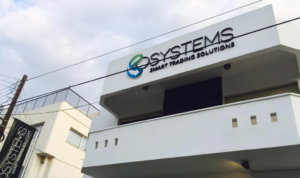Exclusive: O-SYSTEMS expands its services into providing automated platforms for regulated FX brokerages
FinanceFeeds speaks to Haim Lagziel, CEO of O-SYSTEMS on the company’s expansion into providing automated retail FX solutions that mean brokers do not need a sales & retention team

The bottom of the barrel has certainly be reached in terms of the major platform providers and market makers that generate the majority of the binary options business worldwide, as the regulatory authorities in various regions, as well as government departments and law enforcement agencies continue their attempts to extinguish the fraudulent activity from existence.
One of the difficulties associated with the entire binary business is that platform providers, which are also market makers, have their roots in the online gambling business rather than in FinTech or genuine electronic trading enterprises, therefore have built their business on operating a weighed casino disguised as a financial product, thus are not part of this industry in any shape or form.
There are exceptions which are technologically led, one being Tradesmarter, whose founder and CEO Yoni Avital recently launched Backpack.io in Singapore, which is a regulatory technology firm that has its roots in the proprietary back end system developed by Tradesmarter.
Another example is O-SYSTEMS, which is a platform development and technology provider which began its operations by serving the binary options brands with its automated platform that requires no sales force,
FinanceFeeds today spoke to O-SYSTEMS CEO Haim Lagziel from his office in Cyprus, who explained that O-SYSTEMS is expanding its technology toward offering fully automated solutions to regulated FX brokerages.
Whilst the will for good quality technology providers to work with binary options brands dwindles, those with innovative products that provide a secure value proposition in other sectors have the ability to rise up.
O-SYSTEMS considers its value proposition to be the fully automated nature of its platform, which is a facet that translates well into retail FX brokerages, many of which are burdened with the cost of operating a traditional organic sales team and a CRM which requires continual lead acquisition in order to attempt to convert clients in a world in which many offerings are very similar and margins are narrow.
Currently, the cost of acquisition for a new binary options customer is approximately $700, which includes the cost of sales staff, real estate in the form of an office large enough to accommodate enough human resources, the buying and regenerating of leads, and the bugbear of the true legacy model of a human resource-heavy business – the high cost of staff turnover.
This $700 is a particularly important metric when assessing the monthly profitability of operating a binary options brand, especially when considering that in 2013, the average revenue from a new binary options customer was approximately equal to what is now the cost of bringing a single client on board, but also the average revenue has now dropped to between $500 and $600 per client for many brands, constituting a $200 first deposit, followed by a customer retention call that often results in a further $200 the same or following day, and then a small amount more until the client goes west.
Whilst the nature of the binary sector is very questionable indeed, those metrics are accurate and are a very useful foundation and yardstick when measuring the importance of bearing in mind client acquisition and retention costs, which are much higher in the retail FX sector.
Mr. Lagziel, therefore, is now taking his automated platform into the regulated FX industry in order to invoke a model in which in which no sales or retention team will feature at all.
Very importantly, the method by which traffic is generated for FX firms is a vital statistic that must be considered. “Currently, most firms in the business are looking at a CPA (Cost Per Acquisition) of between $1000 and $1500, and within that particular customer base, 70% of the live accounts that are opened fit into the category of those which are relative novices in the financial markets scetor” said Mr. Lagziel.
“We learned when providing platforms to binary options bands that the expectations of this type of client base are considerably different to those of retail FX firms, because within the traditional model of using sales calls, a client who may deposit an initial $250 often thinks that he will be rich and win, rather like in a fixed bet made on an online lottery, as opposed to making strategic analysis about manually trading a financial market. Because of this, the lifetime value of such clients is very very low indeed. By engaging customers via an automated system and not going down the traditional route, lifetime value can be extended exponentially, and the customer demographic can be much more sustainable” – Haim Lagziel, CEO, O-SYSTEMS.
Therefore, the revenue model in many cases is negative, just as it can be among smaller retail FX brokers so what is the solution?
Cutting the cost by using automation of customer retention and optimizing what has become colloquially known as a ‘dead lead’ list has been a focus for many retail binary options brands for over a year now, however automating the entire process has not featured, until now.
It could be argued that within retail FX, or exchange-traded binary options, the high-touch, customer service-orientated model is essential however many retail traders would perhaps respond to an automated service. Plus500 have mastered this very accurately indeed, for example.
“Retail FX customers need to engage more with their broker, they are trading a spot transaction and rely on analytics, news, educational services and signals to make their decisions, however they can do this once they are a customer, purely on a customer service basis rather than sales and retention, therefore brokers which understand this can reduce their costs and maximize their profits exponentially by using a fully automated system and not having to have the headache and cost of running a call center” – Haim Lagziel, CEO, O-SYSTEMS.
Mr. Lagziel confirmed today that O-SYSTEMS has onboarded its first regulated FX brokerage, and the firm is in active discussions with several other larger companies in order that they can take their automated product which works in conjunction with brokers that have a MetaTrader 4 license, as well as CFD platforms. The firm is also developing an automated webtrader solution for FX and is focusing its R&D budget toward the development of automated systems that are specific to the spot FX business.









